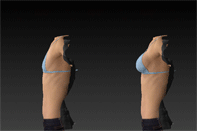As one of the most common cosmetic surgeries within the United States, breast implants are continuously growing in popularity.
As they continue to grow in popularity there are more and more misconceptions to be found when it comes to breast implants. For instance, did you know that breast implants do not last forever?
While breast implants can last for long periods of time without causing problems or needing to be removed/replaced, they are not permanent and will require some maintenance at some point in your life.
The technology used in breast implants today is much better than that of breast implants in the past, which leads to them being more stable and having a longer lifespan. This means that regardless of the type of implant you choose, you should get more life out of them today than you would have even 20 years ago.
What are the Different Types of Breast Implants?
There are two main types of breast implants these days, saline and silicone. Each different type of breast implant comes with its pros and cons, but, you’ll be safe no matter which option you choose, but you should definitely talk with your doctor to figure out which implant type is right for you.
While both saline and silicone breast implants have silicone shells, the big difference between the two lies in how the actual implant is formed. Saline breast implants are filled with sterile salt water, whereas silicone breast implants are pre-filled with silicone. This thick gel closely mimics the consistency of natural fatty tissue.
Choosing an implant type should be based on the look and feel that you’re looking to achieve, while also taking into consideration the different methods that are required to implant them in your chest. Saline implants tend to have a smaller incision due to the fact that they are inserted into the body while flat and then filled up with saline, whereas the silicone implants come pre-filled before being inserted.
This can lead to differences in healing as well as the way the implants may sit in your chest, which is why it’s very important to discuss all options with your surgeon before you make a decision.
How Long Do Breast Implants Last? Do They Need to be Replaced?
This is probably one of the most common questions people inquire about when it comes to breast augmentation surgery – how long will the results last? The answer is, while it is possible for silicone breast implants to last for a lifetime, they may need to be replaced at some point. The older 2nd generation implants typically were all ruptured or leaking by 10 years post-surgery, but the current 5th generation gel implants remain mostly intact at 10 or even 20 years.
According to the FDA, it’s important that women continuously monitor their implants throughout their lifetime. Silicone implant ruptures are difficult to detect; they cannot be detected simply by looking at or feeling the augmented breast. The gel material is inert, so if a rupture does occur, the gel will not be absorbed by the body, so the appearance will not change.
For this reason, some patients will schedule MRIs or ultrasounds to look for any changes or ruptures in the outer shell, which are two determining factors in implant replacement.
Implants must be replaced if a rupture does occur, however. Without replacement, a ruptured silicone breast implant can cause breast pain, tenderness, or changes in the shape of the breast.
While breast implants are not permanent, as in they will not last you a lifetime, they will last you quite a long time and shouldn’t give you any major issues during that time. Of course, there is always the possibility of rupture or tearing due to your lifestyle or an accident, but from regular normal levels of stress, your breast implants should last you 10-20 years.
Why Would a Breast Implant Need to be Replaced or Removed?
There are a number of reasons why you may have to get your breast implant removed or replaced as you begin to age. If the implant has not ruptured there still may be other complications that can arise from having breast implants that may be a reason to have the removed or replaced.
Rupture
As we mentioned above, if a breast implant ruptures then it must be removed or replaced. If a saline breast implant ruptures, the saline solution will harmlessly be absorbed into the body, however you may notice your breast tissue deflate fairly quickly.
If a silicone implant ruptures it may not be immediately noticeable, in terms of your breast deflating, but the silicone can start to cause a burning sensation in your chest.
Capsular Contracture
Capsular contracture is when the tissue around the breast implant begins to scar and harden. This can cause pain, misshapen breasts, breasts to be too firm, or other problems. If this happens, the breast augmentation will have to be revised.
Rippling
If you’ve experienced significant weight loss after having your implants, you may notice that your breasts appear to have slight ripples in them. Rippling is not harmful, but it may cause your breasts to look a bit off, which could be a reason you would want them removed or replaced.
Shift in Position
While the breast implants are typically implanted in an area where they cannot move around a lot, there are times when the implants do shift in the chest cavity. This can be from trauma, hard impact, or even just the way your tissue is as you get older. In many cases women opt to remove or correct the implants through a revision augmentation to ensure that the breasts are positioned exactly where they would like them on their chest.
Desire to Change Size
One of the most common reasons we see people having their breast implants removed or replaced is that they no longer like the size that they originally chose.
Deciding to go bigger or go smaller, or change the type of implant you have, will require you to have your implants removed and replaced in order to change the size.
Breast Implant Replacement or Removal
Whether you’re considering breast augmentation or simply curious about the process, understanding the basics of silicone breast implants, including how long they last, is important.
If you’d like to know more about breast augmentation surgery, contact Dr. Adams today to schedule a consultation or to ask any questions you may have.














